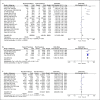The Global Spread of Severe Obesity in Toddlers, Children, and Adolescents: A Systematic Review and Meta-Analysis
- PMID: 35016185
- PMCID: PMC9021657
- DOI: 10.1159/000521913
The Global Spread of Severe Obesity in Toddlers, Children, and Adolescents: A Systematic Review and Meta-Analysis
Abstract
Introduction: Severe obesity among children and adolescents has emerged as a public health concern in multiple places around the world.
Methods: We searched the Medline database for articles on severe obesity rates in children published between January 1960 and January 2020. For studies with available prevalence rates for an early and a more recent time period, the relative increase in prevalence was imputed.
Results: In total, 874 publications were identified, of which 38 contained relevant epidemiological data. Rates of severe obesity varied significantly according to age, gender, geographic area, and the definition of severe obesity. The highest rates of class II and III obesity in the USA according to the Centers of Disease Control cut-off were 9.5% and 4.5%, respectively. Seventeen studies reported prevalence rates in at least two time periods. Data for 9,190,718 individuals showed a 1.71 (95% CI, 1.53-1.90) greater odds for severe obesity in 2006-2017 (N = 5,029,584) versus 1967-2007 (N = 4,161,134). In an analysis limited to studies from 1980s with a minimum follow-up of 20 years, a 9.16 (95% CI, 7.76-10.80) greater odds for severe obesity in recent versus earlier time was found. An analysis limited to studies from 2000, with a follow-up of 5-15 years, a 1.09 (95% CI, 0.99-1.20) greater odds was noted when comparing (2011-2017; N = 4,991,831) versus (2000-2011; N = 4,134,340).
Conclusion: Severe pediatric obesity is escalating with a marked increase from the 1980s and a slower rate from 2000.
Keywords: Childhood; Infancy; Severe obesity.
© 2022 The Author(s). Published by S. Karger AG, Basel.
Conflict of interest statement
The authors of this manuscript have no conflicts of interest to declare.
Figures
References
-
- Nguyen JV, Robbins JM, Houck KL, Nobis EA, Inman KA, Khan KS, et al. Severe obesity and high blood pressure among children, Philadelphia health centers, 2010. J Prim Care Community Health. 2014;5:152–5. - PubMed
-
- Barlow SE, Dietz WH. Obesity evaluation and treatment: expert committee recommendations. The maternal and child health bureau, health resources and services administration and the department of health and human services. Pediatrics. 1998;102:E29. - PubMed
Publication types
MeSH terms
LinkOut - more resources
Full Text Sources
Medical


